Choosing a container can often be a complex decision. There will always be trade-offs to consider with respect to price, durability, reusability and protection. Here is a Checklist of factors to consider when selecting a container from two or more package types. Use as many copies of this table as are required to compare all your packaging options.
Describe each package type, then fill out the table to see which package has the most positive characteristics and will therefore be the best choice for the intended market.
1) Give ratings to the characteristics for different types of packaging.
+2 = excellent
+1 = good
0 = fair
-1 = unsuitable
-2 = extremely unsuitable.
2) Give each characteristic a value from 0 to 100. The total for all 24 characteristics for each package should add up to 100.
|
Package |
Package |
Multiply |
Package |
Package |
Multiply |
Describe package
|
|
|
|
|
|
|
CONTAINING |
|
|
|
|
|
|
1. Suitable capacity for the range of produce |
|
|
|
|
|
|
2. Easily handled by one person |
|
|
|
|
|
|
3. Standard design, meets standards and marketing demand |
|
|
|
|
|
|
4. Palletization ease
|
|
|
|
|
|
|
PROTECTING |
|
|
|
|
|
|
5. Stable when stacked
|
|
|
|
|
|
|
6. Consistent dimension resist the pressure when stacked |
|
|
|
|
|
|
7. Good ventilation
|
|
|
|
|
|
|
8. Protection during handling, transport and marketing |
|
|
|
|
|
|
9. Smooth surface material, no sharp edges |
|
|
|
|
|
|
10. Liners available
|
|
|
|
|
|
|
11. Easy to clean
|
|
|
|
|
|
|
12. Pilfer proof /closed with cover |
|
|
|
|
|
|
COMMUNICATING |
|
|
|
|
|
|
13. Easy to attach label
|
|
|
|
|
|
|
14. Advertisement/ Brand name on box |
|
|
|
|
|
|
MARKETING |
|
|
|
|
|
|
15. Presentation
|
|
|
|
|
|
|
16. Acceptable for customs control |
|
|
|
|
|
|
COST-MISCELLANEOUS |
|
|
|
|
|
|
17. Reasonable purchase cost
|
|
|
|
|
|
|
18. Durable/Deterioration
|
|
|
|
|
|
|
19. Repairable
|
|
|
|
|
|
|
20. Consistent supply guaranteed |
|
|
|
|
|
|
21. Low cargo volume when empty |
|
|
|
|
|
|
22. Local manufacturing possible |
|
|
|
|
|
|
23. Transport/fitting an pick-up or handcart |
|
|
|
|
|
|
24. Loss of crates
|
|
|
|
|
|
|
TOTAL POINTS
|
|
|
|
|
||
3) Multiply for each package the rating for each characteristic times its value and record the new value.
4) Add up the total points for each type of package. Does the package that receives the most points match your preference? What are the differences between the two packages with the highest score? If one is lower in price that may be your best choice.
Source: Schuur, C.C.M. 1988. Packaging for fruits, vegetables and root crops. Food and Agriculture Organization of the United Nations, Bridgetown , Barbados
Adding a fiberboard divider to a carton will increase stacking strength. The use of dividers is common with heavy crops such as melons. The dividers also prevent melons from vibrating against one another during handling and transport. Wooden inserts, or fiberboard folded into triangles and placed in all four corners can be especially useful when a carton needs strengthening.
Fiberboard divider:
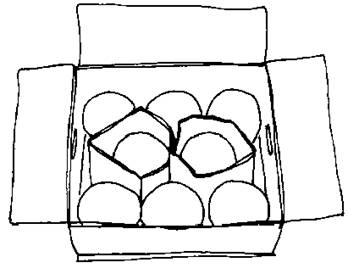
Source: McGregor, B. 1987. Tropical Products Transport Handbook. USDA, Office of Transportation, Agricultural Handbook Number 668.
Triangular corner supports:
|
|
Simple corner supports can be made from wooden blocks or folded fiberboard. | |||
| The fiberboard used the construct the carton corners can be folded inward to reinforce the corner and increase stacking strength. |
When locally made containers have sharp edges or rough inner surfaces, a simple, inexpensive inner made from fiberboard can be used to protect produce from damage during handling.
Cardboard liner for a palm rib crate:
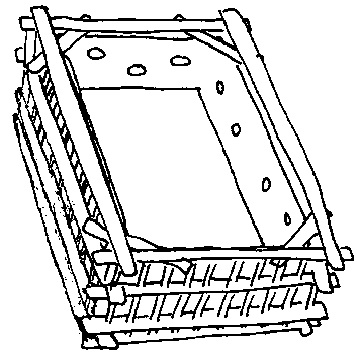
Source: Blond, R.D. 1984. The Agricultural Development Systems Project in Egypt (1979-83), USAID/Ministry of Agriculture , Egypt / University of California , Davis .
If large bags or baskets must be used for bulk packaging of fruits or vegetables, the use of a simple vent can help reduce the buildup of heat as the product respires. In the illustration below, a tube of woven bamboo (about one meter long) is used to vent a large bag of chili peppers. Place the vent tube into the container before filling the container with product.
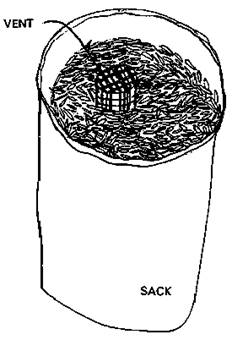
The woven bamboo tube allows air to reach the center of the sack or basket during handling.
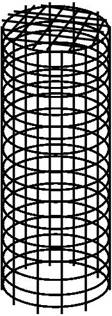
Thin paper or plastic sleeves are a useful material for protecting cut flowers from damage during handling and transport. In the illustration below, a packer is pulling a sleeve up over a bunch of flowers before packing the flowers into a vented fiberboard carton. The sleeves both provide protection and help keep the bunches of flowers separate inside the box.
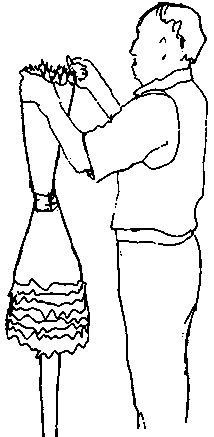
Source: Reid, M.S. 2002. In: Kader, A.A. (Ed.) Postharvest Technology of Horticultural Crops. University of California , Division of Agriculture and Natural Resources, Publication 3311.
Labeling packages helps handlers to keep track of the produce as it moves through the postharvest system, and assists wholesalers and retailers in using proper practices. Labels can be preprinted on fiberboard boxes, or glued, stamped or stenciled on to containers. Brand labeling packages can aid in advertising for the product's producer, packer and/or shippers. Some shippers also provide brochures detailing storage methods or recipes for consumers.
Shipping labels can contain some or all of the following information:
Labeling of consumer packages is mandatory under FDA regulations. Labels must contain the name of the product, net weight, and name and address of the producer, packer or distributor.
Source: McGregor, B. 1989. Tropical Products Transport Handbook. USDA, Office of Transportation, Agricultural Handbook Number 668.